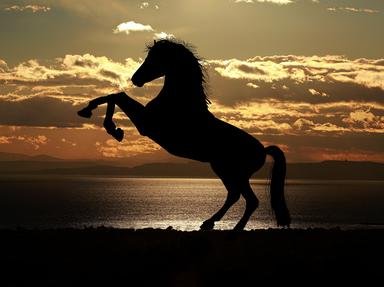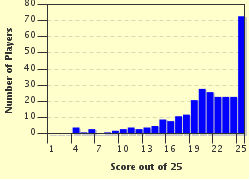Quiz Answer Key and Fun Facts
1. The first horse to pass by as the horses entered in the Melbourne Cup were paraded was Dunedan, whose jockey wore yellow with blue stars. I was reminded of the Dunedain, or Men of the West, in J.R.R. Tolkien's Middle Earth. Which Dunedan played a significant role in 'The Lord of the Rings'?
2. Watching Americain, the second horse to enter the mounting yard, with a jockey looking as if he had sacrificed an American flag to make his colours, I was reminded that the first Tuesday in November is special for Americans as well as for Melbournians. What American event usually occurs, once every four years, on the same date as the Melbourne Cup?
3. Jakkalberry, whose jockey sported fluorescent yellow silks with navy blue seams, was third to cross my field of view. I was reminded of the equally strangely-named (to my ears) huckleberry. What kind of animated character named Huckleberry had his own televised cartoon show from 1958 until 1961?
4. Since the French word for gifts is cadeaux, I immediately thought of gift-giving occasions when I saw Red Cadeaux, the fourth horse to enter the enclosure. His jockey was wearing blue and red silks, and I wondered why they hadn't chosen a colour combination more in keeping with the traditional colours associated with the festive season of Christmas. Had they done so, which of the following sets of silks might the jockey have been wearing?
5. Winchester was the fifth horse to enter the parade area, and I immediately started singing the New Vaudeville Band's 1966 hit song 'Winchester Cathedral' under my breath. That set me wondering, in what country is Winchester Cathedral located?
6. As the sixth horse entered the enclosure, I discovered that Voila Ici is pronounced Voila Itchy, at least by the announcer on the television. That reminded me of a mnemonic rhyme I learned as a child, "Leaves of three, let it be." This was intended to help me avoid developing an itchy rash from contact with which plant?
7. The seventh horse, a black horse whose jockey wore blue silks, was Cavalryman. I would be surprised if any horses as valuable as Cavalryman were involved in the famous Charge of the Light Brigade, a portion of the battle of Balaclava from the Crimean War. What was the nationality of the members of the Light Brigade?
8. Horse number eight, sporting grey colours with a beige star, walked past, and I was immediately reminded of one of my favourite books. Which of these might have been suggested by seeing a horse named Mount Athos?
9. Sanagas's jockey was resplendent in royal blue, with a large silver horseshoe on his chest. I misheard the name of this ninth horse, and thought it was Sangers, which immediately made me hungry. What kind of food is colloquially called a sanger in Melbourne?
10. Tenth in line for the parade was Ethiopia, sporting light blue and green colours. Ethiopia, of course, is the English name of a country in Africa whose name comes from the Greek word for the area where it is found. What name, derived from an Arabic word for the region, was also formerly used?
11. Fiorente was the eighth runner to enter, and I was immediately reminded of a Tuscan city that is often considered to have been the birthplace of the Renaissance in Europe. If the horse's owners had intended to pay homage to that city, they would probably have designed the jockey's silks to bear a fleur de lis, instead of being black with a purple sash. What city, home to the powerful Medici family, had leaped into my mind?
12. Another Italian-themed horse entered the enclosure, a brown gelding whose jockey was clad in a purple shirt decorated with a yellow cross of Lorraine (one with two crosspieces). The twelfth entrant was named after a scientist who is often considered the father of modern science, due to his extensive work in physics, mathematics and astronomy. He is possibly best known for choosing to defy the Inquisition and uphold a heliocentric model of the universe. Which of these horses has a name that might have brought this man to my thoughts?
13. Horse number thirteen, Glencadam Gold, came striding along, and I wondered why the jockey wore white, red and grey, instead of gold. Mine not to reason why, so I moved on to wondering if the owners knew about the Glencadam Distillery, and the lovely gold whisky they produce. Where would I have to go to visit the distillery?
14. Green Moon, a handsome brown horse whose jockey sported navy blue silks, was the fourteenth horse to be led past. We've all heard that the moon is made of green cheese. Is there actually such a thing as green cheese?
15. As Maluckyday pranced past bearing the number fifteen on his saddlecloth, I wondered if it would be a lucky day for him and his jockey. I also thought the silks could have had a more appropriate design than a grey sash and pink striped sleeves. Which of these possible designs is NOT suggestive of good luck?
16. Watching Mourayan and his navy-clad jockey parade past, I remembered learning something about moraines in school. In which of these classes did the topic probably arise?
17. Next I saw My Quest for Peace, a magnificent stallion in blue, white and yellow silks, and I thought of the 'Road Map for Peace' which was proposed in 2002 as a plan for resolving the Israeli-Palestinian conflict. This was one in a series of initiatives to secure peace in which region?
18. As I watched Niwot parading past, with his jockey bearing a gold thunder bolt on a navy background, I noticed that his name made sense when I wrote it in reverse: To win. What is the name for a word, sentence or number that is exactly the same when it is written in reverse?
19. Tac de Boistron, yet another horse whose jockey sported navy, this time with fluorescent yellow braces, was the nineteenth horse to come into view. The handsome grey gelding showed a bit of spirit, and his name reminded me of a word my mother used to describe her three children, who sometimes got a bit bouncy when confined indoors all day on a winter Saturday. Which of these terms might she have chosen?
20. I saw Lights in Heaven quite clearly as she paraded past, twentieth in line, with yet another navy-clad jockey. Which of these celestial objects can you NOT see with the naked eye?
21. At last, a horse wearing non-navy silks came into the enclosure. This seven-year-old gelding by Zabeel out of Kowtow was trained by Bart Cummings, who is often referred to as 'The Cup King', because he has trained so many winners. What name did the horse carrying the number 21 have, that suggested its trainer's previous successes?
22. As Unusual Suspect entered the enclosure, sporting black silks with a silver star in a white disc, silver sleeves and a red cap (now that's a mouthful of a description), the name of the third from last horse reminded me of one of my favourite movies. Which movie, with a title taken from the movie 'Casablanca', was it?
23. The second to last horse, Zabeelionaire, walked by with his jockey in bright blue and yellow, and I got to thinking about a crotchety old billionaire in my favourite TV show, 'The Simpsons', who runs a nuclear power plant. Who was I thinking of?
24. By the time the last horse, Kelinni, came past, I had worked up a bit of an appetite, and his name immediately made me think of organizing some sweet pastry treats for my afternoon snack. Which of these was I dreaming of as the jockey came past wearing a maroon shirt with crossed white sashes and yellow armbands?
25. And the winner of the 2012 Melbourne Cup proved to be something of an outsider, starting at odds of 20-1. Which of these horses, whose name suggests an unlikely event as described by someone suffering from poor colour distinction, was the winner?
Source: Author
looney_tunes
This quiz was reviewed by FunTrivia editor
Exit10 before going online.
Any errors found in FunTrivia content are routinely corrected through our feedback system.

